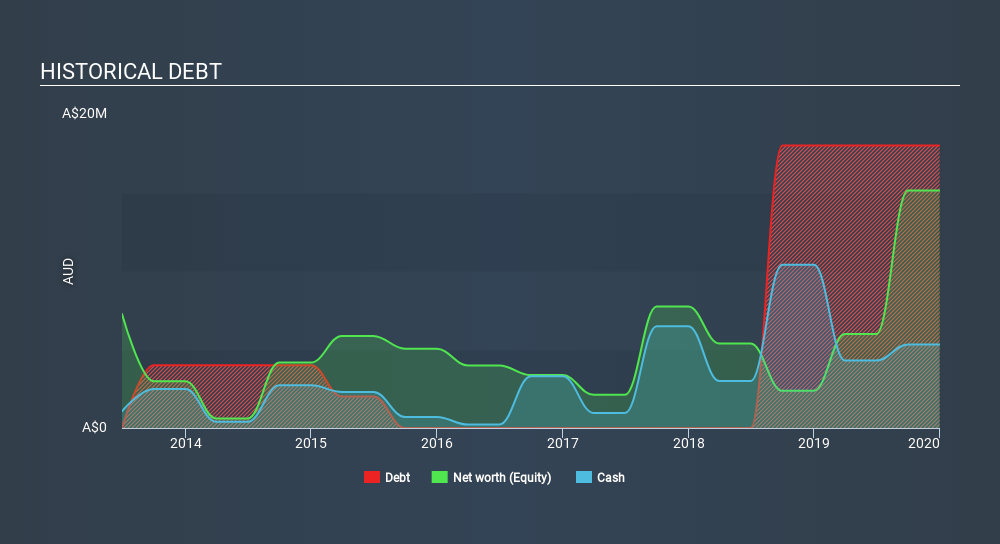
David Iben put it well when he said, 'Volatility is not a risk we care about. What we care about is avoiding the permanent loss of capital. So it might be obvious that you need to consider debt, when you think about how risky any given stock is, because too much debt can sink a company. We can see that Beacon Minerals Limited (ASX:BCN) does use debt in its business. But the real question is whether this debt is making the company risky.
When Is Debt Dangerous?
Debt is a tool to help businesses grow, but if a business is incapable of paying off its lenders, then it exists at their mercy. Ultimately, if the company can't fulfill its legal obligations to repay debt, shareholders could walk away with nothing. However, a more frequent (but still costly) occurrence is where a company must issue shares at bargain-basement prices, permanently diluting shareholders, just to shore up its balance sheet. Of course, the upside of debt is that it often represents cheap capital, especially when it replaces dilution in a company with the ability to reinvest at high rates of return. The first thing to do when considering how much debt a business uses is to look at its cash and debt together.
View our latest analysis for Beacon Minerals
How Much Debt Does Beacon Minerals Carry?
The chart below, which you can click on for greater detail, shows that Beacon Minerals had AU$18.0m in debt in December 2019; about the same as the year before. However, it also had AU$5.33m in cash, and so its net debt is AU$12.7m.

How Strong Is Beacon Minerals's Balance Sheet?
We can see from the most recent balance sheet that Beacon Minerals had liabilities of AU$3.66m falling due within a year, and liabilities of AU$18.0m due beyond that. Offsetting these obligations, it had cash of AU$5.33m as well as receivables valued at AU$1.99m due within 12 months. So its liabilities outweigh the sum of its cash and (near-term) receivables by AU$14.3m.
Given Beacon Minerals has a market capitalization of AU$105.9m, it's hard to believe these liabilities pose much threat. But there are sufficient liabilities that we would certainly recommend shareholders continue to monitor the balance sheet, going forward. When analysing debt levels, the balance sheet is the obvious place to start. But it is Beacon Minerals's earnings that will influence how the balance sheet holds up in the future. So when considering debt, it's definitely worth looking at the earnings trend. Click here for an interactive snapshot.
While it hasn't made a profit, at least Beacon Minerals booked its first revenue as a publicly listed company, in the last twelve months.
Caveat Emptor
While we can certainly savour Beacon Minerals's tasty revenue growth, its negative earnings before interest and tax (EBIT) leaves a bitter aftertaste. To be specific the EBIT loss came in at AU$3.5m. Considering that alongside the liabilities mentioned above does not give us much confidence that company should be using so much debt. Quite frankly we think the balance sheet is far from match-fit, although it could be improved with time. Another cause for caution is that is bled AU$21m in negative free cash flow over the last twelve months. So in short it's a really risky stock. When analysing debt levels, the balance sheet is the obvious place to start. But ultimately, every company can contain risks that exist outside of the balance sheet. Consider for instance, the ever-present spectre of investment risk. We've identified 5 warning signs with Beacon Minerals (at least 1 which makes us a bit uncomfortable) , and understanding them should be part of your investment process.
At the end of the day, it's often better to focus on companies that are free from net debt. You can access our special list of such companies (all with a track record of profit growth). It's free.
Love or hate this article? Concerned about the content? Get in touch with us directly. Alternatively, email editorial-team@simplywallst.com.
This article by Simply Wall St is general in nature. It does not constitute a recommendation to buy or sell any stock, and does not take account of your objectives, or your financial situation. We aim to bring you long-term focused analysis driven by fundamental data. Note that our analysis may not factor in the latest price-sensitive company announcements or qualitative material. Simply Wall St has no position in any stocks mentioned. Thank you for reading.
About ASX:BCN
Beacon Minerals
Engages in the mineral exploration, development, and production activities in Western Australia.
Excellent balance sheet and slightly overvalued.
Similar Companies
Market Insights
Community Narratives



